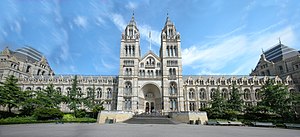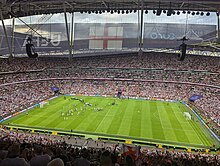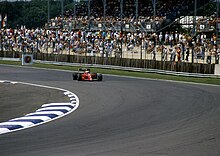ENGLAND
Cinema
See also: Cinema of the United Kingdom Peter O'Toole as T. E. Lawrence in David Lean's 1962 epic Lawrence of Arabia
Peter O'Toole as T. E. Lawrence in David Lean's 1962 epic Lawrence of Arabia
England has had a considerable influence on the history of the cinema, producing some of the greatest actors, directors and motion pictures of all time, including Alfred Hitchcock, Charlie Chaplin, David Lean, Laurence Olivier, Vivien Leigh, John Gielgud, Peter Sellers, Julie Andrews, Michael Caine, Gary Oldman, Helen Mirren, Kate Winslet and Daniel Day-Lewis. Hitchcock and Lean are among the most critically acclaimed filmmakers.[302] Hitchcock's The Lodger: A Story of the London Fog (1926) helped shape the thriller genre in film, while his 1929 Blackmail is often regarded as the first British sound feature film.[303]
Major film studios in England include Pinewood, Elstree and Shepperton. Some of the most commercially successful films of all time have been produced in England, including two of the highest-grossing film franchises (Harry Potter and James Bond).[304] Ealing Studios in London has a claim to being the oldest continuously working film studio in the world.[305] Famous for recording many motion picture film scores, the London Symphony Orchestra first performed film music in 1935.[306] The Hammer Horror films starring Christopher Lee saw the production of the first gory horror films showing blood and guts in colour.[307]
The BFI Top 100 British films includes Monty Python's Life of Brian (1979), a film regularly voted the funniest of all time by the UK public.[308] English producers are also active in international co-productions and English actors, directors and crew feature regularly in American films. The UK film council ranked David Yates, Christopher Nolan, Mike Newell, Ridley Scott and Paul Greengrass the five most commercially successful English directors since 2001.[309] Other contemporary English directors include Sam Mendes, Guy Ritchie and Richard Curtis. Current actors include Tom Hardy, Daniel Craig, Benedict Cumberbatch, Lena Headey, Felicity Jones, Emilia Clarke, Lashana Lynch, and Emma Watson. Acclaimed for his motion capture work, Andy Serkis opened The Imaginarium Studios in London in 2011.[310] The visual effects company Framestore in London has produced some of the most critically acclaimed special effects in modern film.[311] Many successful Hollywood films have been based on English people, stories or events. The 'English Cycle' of Disney animated films include Alice in Wonderland, The Jungle Book and Winnie the Pooh.[312]
Sites and institutions
Further information: List of museums in England The Natural History Museum in London
The Natural History Museum in London
English Heritage is a governmental body with a broad remit of managing the historic sites, artefacts and environments of England. It is currently sponsored by the Department for Culture, Media and Sport. A non-governmental charity, the National Trust holds a complementary role, focussed on landscapes and country houses. 17 of the 25 United Kingdom UNESCO World Heritage Sites fall within England.[313] Some of the best-known of these are: Hadrian's Wall, Stonehenge, Avebury and Associated Sites, the Tower of London, the Jurassic Coast, Saltaire, Ironbridge Gorge, Blenheim Palace and the Lake District.[314]
London's British Museum holds more than seven million objects,[315] one of the largest and most comprehensive collections in the world,[316] illustrating and documenting global human culture from its beginnings to the present. The British Library in London is the national library and is one of the world's largest research libraries, holding over 150 million items in almost all known languages and formats, including around 25 million books.[317][318] The National Gallery in Trafalgar Square houses a collection of over 2,300 paintings dating from the mid-13th century to 1900.[319] The Tate galleries house the national collections of British and international modern art; they also host the Turner Prize.[320]
The Secretary of State for Culture, Media and Sport has overall responsibility for cultural property and heritage.[321][322] A blue plaque, the oldest historical marker scheme in the world, is a permanent sign installed in a public place in England to commemorate a link between that location and a famous person or event. In 2011 there were around 1,600 museums in England.[323] Entry to most museums and galleries is free.[324] London is one of the world's most visited cities, regularly taking the top five most visited cities in Europe. It is considered a global centre of finance, art and culture.[325]
Media
Main article: Media in the United Kingdom MediaCity in Manchester is the largest media-production facility in Europe.[326]
MediaCity in Manchester is the largest media-production facility in Europe.[326]
The BBC, founded in 1922, is a publicly funded radio, television and Internet broadcasting corporation, and is the oldest and largest broadcaster in the world.[327][328] It operates numerous television and radio stations in the UK and abroad and its domestic services are funded by the television licence.[329][330] The BBC World Service is an international broadcaster owned and operated by the BBC. It is the world's largest of any kind.[331] It broadcasts radio news, speech and discussions in more than 40 languages.[332][333]
London dominates the media sector in England: national newspapers and television and radio are largely based there, although Manchester is also a significant national media centre. The UK publishing sector, including books, directories and databases, journals, magazines and business media, newspapers and news agencies, has a combined turnover of around £20 billion and employs around 167,000 people.[334] National newspapers produced in England include The Times, The Guardian, The Daily Telegraph, and the Financial Times.[335]
Magazines and journals published in England that have achieved worldwide circulation include Nature, New Scientist, The Spectator, New Statesman, Prospect, NME and The Economist. The Secretary of State for Culture, Media and Sport has overall responsibility over media and broadcasting in England.[336]
Sport
Main article: Sport in England Queen Elizabeth II presenting the World Cup trophy to 1966 World Cup winning England captain Bobby Moore
Queen Elizabeth II presenting the World Cup trophy to 1966 World Cup winning England captain Bobby Moore
England has a strong sporting heritage, and during the 19th century codified many sports that are now played around the world. Sports originating in England include association football,[337] cricket, rugby union, rugby league, tennis, boxing, badminton, squash,[338] rounders,[339] hockey, snooker, billiards, darts, table tennis, bowls, netball, thoroughbred horseracing, greyhound racing and fox hunting. It has helped the development of golf, sailing and Formula One.
Football is the most popular of these sports. The England national football team, whose home venue is Wembley Stadium, played Scotland in the first ever international football match in 1872.[340] Referred to as the "home of football" by FIFA, England hosted and won the 1966 FIFA World Cup.[341] With a British television audience peak of 32.30 million viewers, the final is the most watched television event ever in the UK.[342] England is recognised by FIFA as the birthplace of club football: Sheffield F.C., founded in 1857, is the world's oldest club.[337] The England women's national football team won the UEFA Euro 2022, hosted by England.[343] Wembley Stadium, home of the England football team, during the UEFA Women's Euro 2022 final. At 90,000 capacity, it is the biggest stadium in the UK and the second-largest stadium in Europe.
Wembley Stadium, home of the England football team, during the UEFA Women's Euro 2022 final. At 90,000 capacity, it is the biggest stadium in the UK and the second-largest stadium in Europe.
Cricket is generally thought to have been developed in the early medieval period among the farming and metalworking communities of the Weald.[344] The England cricket team is a composite England and Wales team. One of the game's top rivalries is The Ashes series between England and Australia, contested since 1882. Lord's Cricket Ground situated in London is sometimes referred to as the "Mecca of Cricket".[345] After winning the 2019 Cricket World Cup, England became the first country to win the World Cups in football, rugby union, and cricket.[346]
William Penny Brookes was prominent in organising the format for the modern Olympic Games.[347] London has hosted the Summer Olympic Games three times, in 1908, 1948, and 2012. England competes in the Commonwealth Games, held every four years. The 2022 Commonwealth Games was held in Birmingham. It was the third Commonwealth Games to be hosted in England, following London 1934 and Manchester 2002. Sport England is the governing body responsible for distributing funds and providing strategic guidance for sporting activity in England.
Rugby union originated in Rugby School, Warwickshire in the early 19th century.[348] The top level of club participation is the English Premiership. The England national rugby union team competes in the annual Six Nations Championship. England have won the championship on 29 occasions (as well as sharing 10 victories), winning the Grand Slam 14 times and the Triple Crown 26 times, making them the most successful outright winners in the tournament's history. They are currently the only team from the Northern Hemisphere to win several Rugby World Cups.[349]
Rugby league was born in Huddersfield in 1895. The England national rugby league team are ranked third in the world and first in Europe. Since 2008, the national rugby league team has been a full test nation in lieu of the Great Britain national rugby league team, which won three World Cups. Club sides play in Super League, the present-day embodiment of the Rugby Football League Championship. Rugby League is most popular among towns in the northern English counties of Lancashire, Yorkshire and Cumbria.[350]
Golf has been prominent in England, due in part to its cultural and geographical ties to Scotland.[351] There are professional tours for men and women, in two main tours: the PGA and the European Tour. The world's oldest golf tournament, and golf's first major is The Open Championship, played both in England and Scotland. The biennial golf competition, the Ryder Cup, is named after English businessman Samuel Ryder.[352]
Tennis was created in Birmingham in the late 19th century, and the Wimbledon Championships is the oldest tennis tournament in the world, and widely considered the most prestigious.[353] Wimbledon has a major place in the English cultural calendar.[354] Former Formula One world champion Nigel Mansell driving at Silverstone in 1990. The circuit hosted the first ever World Championship Formula One race in 1950.
Former Formula One world champion Nigel Mansell driving at Silverstone in 1990. The circuit hosted the first ever World Championship Formula One race in 1950.
In boxing, under the Marquess of Queensberry Rules, England has produced many world champions across the weight divisions internationally recognised by the governing bodies.[355]
Originating in 17th and 18th-century England, the thoroughbred is a horse breed best known for its use in horse racing. The National Hunt horse race the Grand National, is held annually at Aintree Racecourse in early April. It is the most watched horse race in the UK, and three-time winner Red Rum is the most successful racehorse in the event's history.[356]
The 1950 British Grand Prix at Silverstone was the first race in the newly created Formula One World Championship.[357][358] It has manufactured some of the most technically advanced racing cars, and many of today's racing companies choose England as their base of operations. England also has a rich heritage in Grand Prix motorcycle racing, the premier championship of motorcycle road racing, and produced several world champions.
Darts is a widely popular sport in England; a professional competitive sport, it is a traditional pub game.[359][360] Another popular sport commonly associated with pub games is snooker, and England has produced several world champions. The English are keen sailors and enjoy competitive sailing; founding and winning some of the world's most famous international competitive tournaments across the various race formats, including the match race, a regatta, and the America's Cup.
National symbols
Main article: National symbols of England The Royal Arms of England
The Royal Arms of England
The St George's Cross has been the national flag of England since the 13th century. Originally the flag was used by the maritime Republic of Genoa. The English monarch paid a tribute to the Doge of Genoa from 1190 onwards so that English ships could fly the flag as a means of protection when entering the Mediterranean. A red cross was a symbol for many Crusaders in the 12th and 13th centuries, and became associated with Saint George.[361] Since 1606 the St George's Cross has formed part of the design of the Union Flag, a Pan-British flag designed by King James I.[222] During the English Civil War and Interregnum, the New Model Army's standards and the Commonwealth's Great Seal both incorporated the flag of Saint George.[362][363] The Tudor rose, England's national floral emblem
The Tudor rose, England's national floral emblem
There are numerous other symbols and symbolic artefacts, both official and unofficial, including the Tudor rose, the nation's floral emblem, and the Three Lions featured on the Royal Arms of England. The Tudor rose was adopted as a national emblem of England around the time of the Wars of the Roses as a symbol of peace.[364] It is a syncretic symbol in that it merged the white rose of the Yorkists and the red rose of the Lancastrians. It is also known as the Rose of England.[365] The oak tree is a symbol of England: the Royal Oak symbol and Oak Apple Day commemorate the escape of King Charles II after his father's execution, when he hid in an oak to avoid detection by the parliamentarians before safely reaching exile.
The Royal Arms of England, a national coat of arms featuring three lions, originated with Richard the Lionheart in 1198. It is blazoned as gules, three lions passant guardant or and it provides one of the most prominent symbols of England. England does not have an official national anthem, as the United Kingdom as a whole has God Save the King. However, Jerusalem, Land of Hope and Glory (used for England during the 2002 Commonwealth Games),[366] and I Vow to Thee, My Country are often considered unofficial English national anthems. England's National Day is 23 April which is Saint George's Day: Saint George is the patron saint of England.[367]
See also
Notes
- ^ ONS Standard Area Measurement, 'total extent of the realm'
- ^ ONS Standard Area Measurement, 'area to mean high water excluding inland water'
- ^ As Roger Scruton explains, "The Reformation must not be confused with the changes introduced into the Church of England during the "Reformation Parliament" of 1529–36, which were of a political rather than a religious nature, designed to unite the secular and religious sources of authority within a single sovereign power: the Anglican Church did not make substantial change in doctrine until later."[56]
- ^ Figure of 550,000 military deaths is for England and Wales.[85]
- ^ For instance, in 1980 around 50 million Americans claimed English ancestry.[192] In Canada there are around 6.5 million Canadians who claim English ancestry.[193] Around 70% of Australians in 1999 denoted their origins as Anglo-Celtic, a category which includes all peoples from Great Britain and Ireland.[194] Chileans of English descent are somewhat of an anomaly in that Chile itself was never part of the British Empire, but today there are around 420,000 people of English origins living there.[195]
- ^ People who strictly identified as "Pagan". Other Pagan paths, such as Wicca or Druidism, have not been included in this number.[225]
- ^ People who strictly identified as "Wiccan". Other Pagan paths, such as Druidism, and general "Pagan" have not been included in this number.[225]
- ^ Students attending English universities now have to pay tuition fees towards the cost of their education, as do English students who choose to attend university in Scotland. Scottish students attending Scottish universities have their fees paid by the devolved Scottish Parliament.[235]
- ^ While people such as Norman Foster and Richard Rogers represent the modernist movement, Prince Charles since the 1980s has voiced strong views against it in favour of traditional architecture and put his ideas into practice at his Poundbury development in Dorset.[248] Architects like Raymond Erith, Francis Johnson and Quinlan Terry continued to practise in the classical style.
- ^ These tales may have come to prominence, at least in part, as an attempt by the Norman ruling elite to legitimise their rule of the British Isles, finding Anglo-Saxon history ill-suited to the task during an era when members of the deposed House of Wessex, especially Edgar the Ætheling and his nephews of the Scottish House of Dunkeld, were still active in the isles.[257][259] Also Michael Wood explains; "Over the centuries the figure of Arthur became a symbol of British history – a way of explaining the matter of Britain, the relationship between the Saxons and the Celts, and a way of exorcising ghosts and healing the wounds of the past."[

















































